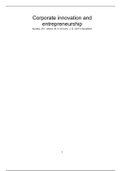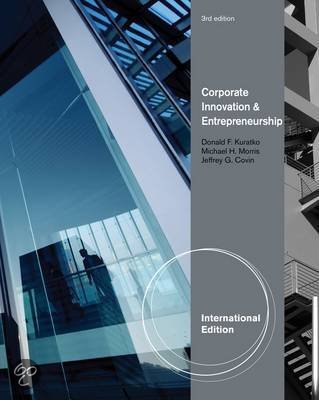Corporate innovation and
entrepreneurship
Kuratko, D.F., Morris, M. H. & Covin, J. G. (2011) 3rd edition
1
,Section 1: Foundations of corporate entrepreneurship
Chapter 1: The entrepreneurial imperative in established
organizations
Entrepreneurial thinking and acting is changing the way business is conducted at every level, in
existing companies as well as start-ups. Entrepreneurship is redefining what is made, how it is
made, where it is sold and how it is distributed. Companies must continually adjust, adapt and
redefine themselves to stay relevant. This is a fundamental principle in a free market economy.
However, in this entrepreneurial age, the rate at which companies must transform themselves is
accelerating. This required new theoretical models, but basic lessons and old principles of good
business still apply. In this chapter, a new paradigm is identified for achieving sustainable
competitive advantage using lessons of conventional management theory.
Turbulent environments and the embattled corporation
To understand corporations, we must consider their external and internal environments.
External refers to everything outside the company, including the competitive, customer,
technological, economic, regulatory, social, labor, and supplier environments. The internal
environment refers to the structures, systems, processes, and culture that make up the climate
within which people do the work of a company. The external environment has always changed,
but the pace and magnitude of change are significantly greater than ever before. Some
examples of development in major domains are:
Technological environment Accelerated development of new technologies
Rapid product obsolescence
Greater difficulty in protecting intellectual property
Economic environment Unpredictability of prices, costs, exchange rates, interest rates,
tax incentives and business cycles
Competitive environment Aggressive ‘take no prisoners’ competition
Highly innovative competitors
Competition from non-traditional sources with non-traditional
tactics
Threats from nice players
Competitors who are also customers or partners
Labor environment Growing scarcity of skilled workers
Employees more mobile and less loyal
Higher employee benefit costs
Reliance on contract labor
2
,Resource environment Increasing resource scarcity
Resources increasingly specialized
Unknown sources of supply
More rapid resource obsolescence
Customer environment More demanding and complex customers
Markets are more fragmented and narrowly segmented
Emphasis on investing in and capturing a customer’s life value
Legal and regulatory More aggressive regulation
Virtually unlimited product liability
Environmental regulatory compliance costs
Growing emphasis on free and fair trade
Increasing environmental regulation and associated compliance
costs
Mandated employee benefit costs
Global environment Real-time communication, production and distribution virtually
anywhere in the world
More sophisticated supplies, customers, and competitors
located around the world
Competitive advantage achieved through global outsourcing
and international strategic alliances
How environmental turbulence creates a need for ne management practices
Customers Technology
Fragmented markets require companies to Companies have to change the ways they
adopt multiple approaches to serve different operate internally and how they compete
target audiences externally based on:
Rapidly rising customer expectations force - New information management
companies to customize their products, technologies (MT)
customer support function, and - New production and service delivery
communication approaches, and yet do so in technologies
ways that can be standardized - New customer MT
- New logistics and inventory MT
The costs of higher level of customization - New salesforce MT
require companies to cultivate longer-term - New product development
customer relationships technologies
Sustainable growth means learning new skills
in serving global markets
Competitors Legal, regulatory and ethical standards
Competitors lead customers to entirely new Companies are increasingly accountable to
market spaces, forcing companies to spend multiple stakeholders, and their actions are
greater amounts on product development more visible to these stakeholders, forcing
3
, Aggressive competitors move quickly to management to make difficult choices and
mimic anything new attempted by the deliver results while behaving responsibly
company, making it harder to differentiate the
company in the eyes of the customers An increasingly litigious environment raises
the stakes on company liability for products
Companies find themselves competing with and how they are used; more lawsuits
companies in other industries that play by increase company costs and penalize
completely different rules - making current innovative action
competitive approaches irrelevant
Regulatory restrictions limit choices while
Competitors specializing in narrow, profitable forcing companies to learn new ways to
niches avoid costs of competing across a compete
broader product and customer range, while
attacking the company’s most profitable areas Growing affluence enables society to hold
of business companies more responsible for the
environmental and social implications of their
actions
→ The embattled corporation
The new path to sustainable competitive advantage
Companies have adjusted to these changing factors differently. Important lessons can be
learned from these different strategies:
- Turbulence in the external environment is causing a fundamental transformation in the
internal operations of companies
- There are no simple formulas for success in the new competitive environments
- New opportunities arise due to the external environment becoming more complex,
dynamic, and hostile
Managers must now seek sustainable competitive advantage. Traditionally, competitive
advantage was achieved by having lower costs than the competition, achieving higher quality or
product performance, adding a new product feature, offering more selection or delivering better
customer service. However, nowadays, whatever one company does is quickly matched by
other companies. Moreover, to be successful today, companies must continually improve to
remain competitive. Remaining competitive is very different from achieving sustainable
competitive advantage. Advantage drives from five key company capabilities:
- Adaptability - ability to adjust, on a timely basis, to new technologies, new customer
needs, new regulatory rules, and other changes in conditions without losing focus or
causing significant disruption of core operations and commitments
- Flexibility - ability to design company strategies, processes, and operational approaches
that can simultaneously meet the diverse and evolving requirements of customers,
distributors, suppliers, financiers, regulators, and other key stakeholders
- Speed - ability to act quickly on emerging opportunities, to develop new product and
services more rapidly, and to make critical operational decision without lengthy
deliberations
- Aggressiveness - an intense, focused, and proactive approach to eliminating
4






